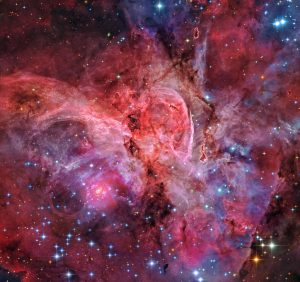Blue Supergiant
Blue is the colour of the hottest stars in the universe with surface temperatures of 20 000°C to 50 000°C. Just for comparison, our own Sun is only 6 000°C. Luminosities range from about 10 000 to a million times that of the sun.
They are also the most massive, 20 times the mass of the sun or more. Indeed it is not usual to find members of this group as much as 150 times the mass of the Sun. They are very unstable. When supergiants die they supernova and become black holes.

Eta Carinae is a notable example, lying some 7 500 light years away. It has a mass more than 100 times that of the sun. It is also classified as “an eruptive variable”. Another is Rigel, shining 40 000 times more brightly than our sun.
Blue Giant
Blue giants are typically between 5 and 10 solar masses. And as the colour suggests they are very hot stars at temperatures of 10 000°C or more. Their spectral class is O or B and sometimes A. It is a post-main sequence star that burns helium. Previous to this stage they could well have been red giants. The stages are very brief. A blue giant is unlikely to live longer than about 180 million years.
Blue Straggler
Blue stragglers are younger than they should be in terms of their mass and luminosity. They result from the collision of two older main sequence stars. They become more massive so together their temperatures escalate, and they become bluer and brighter.
White Giant
More often than not stars at this stage are blue giants, but there are some that astronomers refer to as “white giants”. They are typically 150 solar masses and of spectral Types B and A.
Red Hypergiant
These stars are the biggest and most powerful, about one million times the size of our Sun. They are bigger than supergiants, of course. They are massive enough to fuse very heavy elements, including iron. They eventually explode as Type-II supernovae. An example is VY Canis Majoris which has a radius of 1 977 million kilometres—almost 1 500 times the diameter of our Sun. It is currently about 30 solar masses and is losing mass at the rate of 30 Earth masses a year. Needless to say it is very unstable.
Red Supergiant
Red supergiants are stars that have exhausted their supply of hydrogen at the core. The outer layers have expanded taking these types off the main sequence. They go through several expansion and contraction phases until they eventually end up as a neutron star or black hole. Their fate is determined by their original mass: if below a solar mass of 3 they will become a neutron star; above 3 a black hole.
Notable examples include Ras Algethi (Alpha Herculis) in the Hercules constellation. It is wider than the orbit of Mars. It is an eclipsing binary, spectral type M5. Another is Antares (Alpha Scorpii) in the constellation Scorpius, spectral type M1.5. It pulses irregularly and has a companion that orbits once every 1 000 years. Antares shines 10 000 times brighter than the sun. Betelgeuse in Orion is another example.
Red Giant
A red giant is a large luminous star with a low surface temperature, hence its reddish colour. It is a star that has evolved away from the main sequence and is now burning helium in its core rather than hydrogen and is approaching the final stages of life. While the core contracts and the outer layers expand, cool, and become less bright. Whether it is a red giant or a red supergiant depends on its initial mass.
A red giant is a relatively old star whose diameter is about 100 times bigger than it was originally and has become cooler. Their spectral class is K or M.
Through violent fusion processes its helium burns into carbon and oxygen and a variety of heavier elements. After this phase it will collapse to become a white dwarf. Low mass stars like our own Sun is a typical example.
An interesting member of this group is TT Cygni in the constellation Cygnus, though not part of the pattern. It is a carbon star, part of a binary or multi-star system. Carbon stars are so named for their apparent abundance of carbon containing molecules. The carbon is more likely the dredged-up ashes of nuclear helium burning. It is about 1 660 light years distant.
Back to Top
By Nigel Benetton, science fiction author of Red Moon Burning and The Wild Sands of Rotar.
Last updated: Saturday, 20 March 2021